maintenance schedule FORD MUSTANG 2022 Warranty Guide
[x] Cancel search | Manufacturer: FORD, Model Year: 2022, Model line: MUSTANG, Model: FORD MUSTANG 2022Pages: 81, PDF Size: 1.96 MB
Page 5 of 81
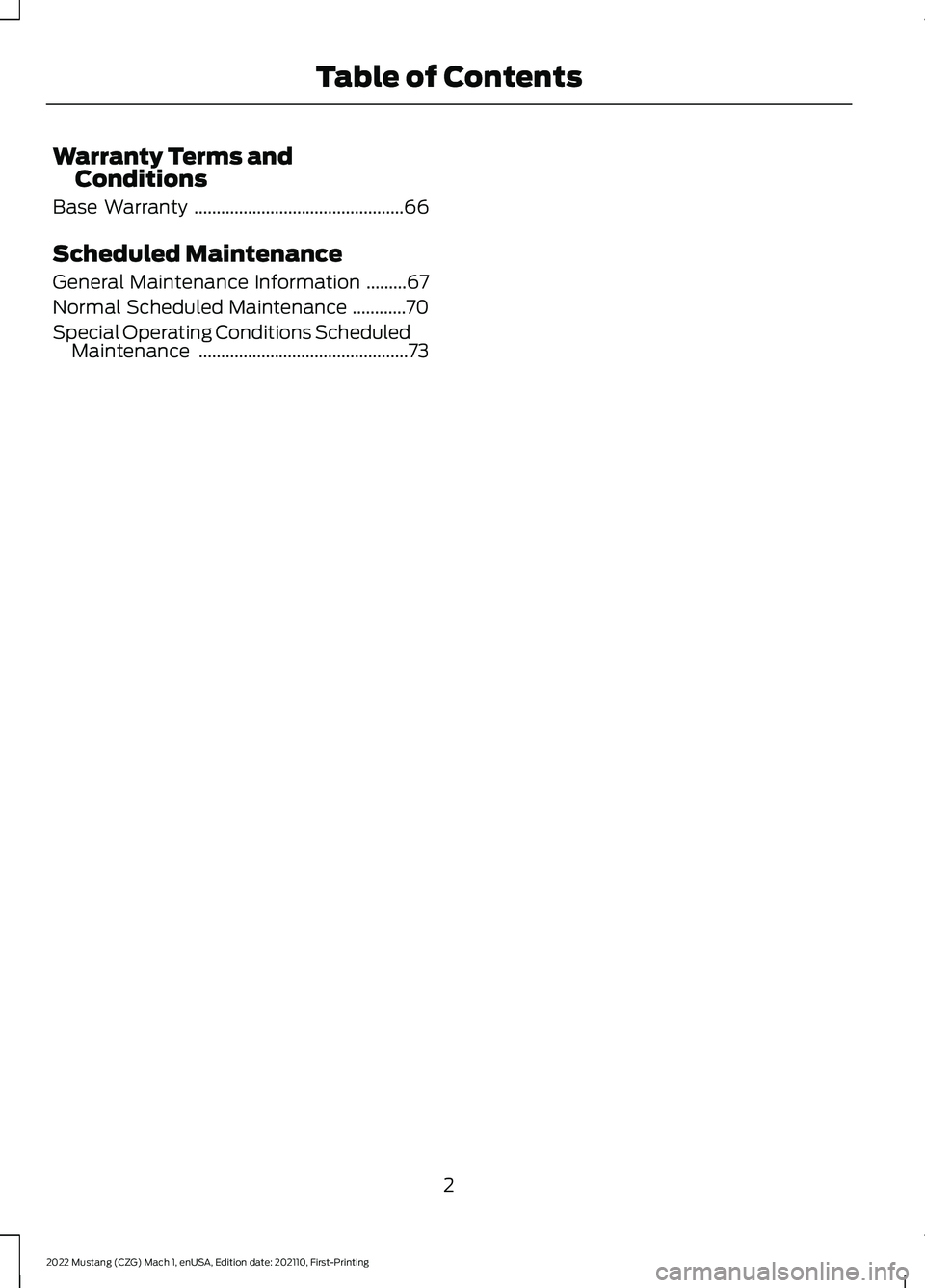
Warranty Terms and
Conditions
Base Warranty ...............................................66
Scheduled Maintenance
General Maintenance Information .........
67
Normal Scheduled Maintenance ............
70
Special Operating Conditions Scheduled Maintenance ...............................................
73
2
2022 Mustang (CZG) Mach 1, enUSA, Edition date: 202110, First-Printing Table of Contents
Page 42 of 81
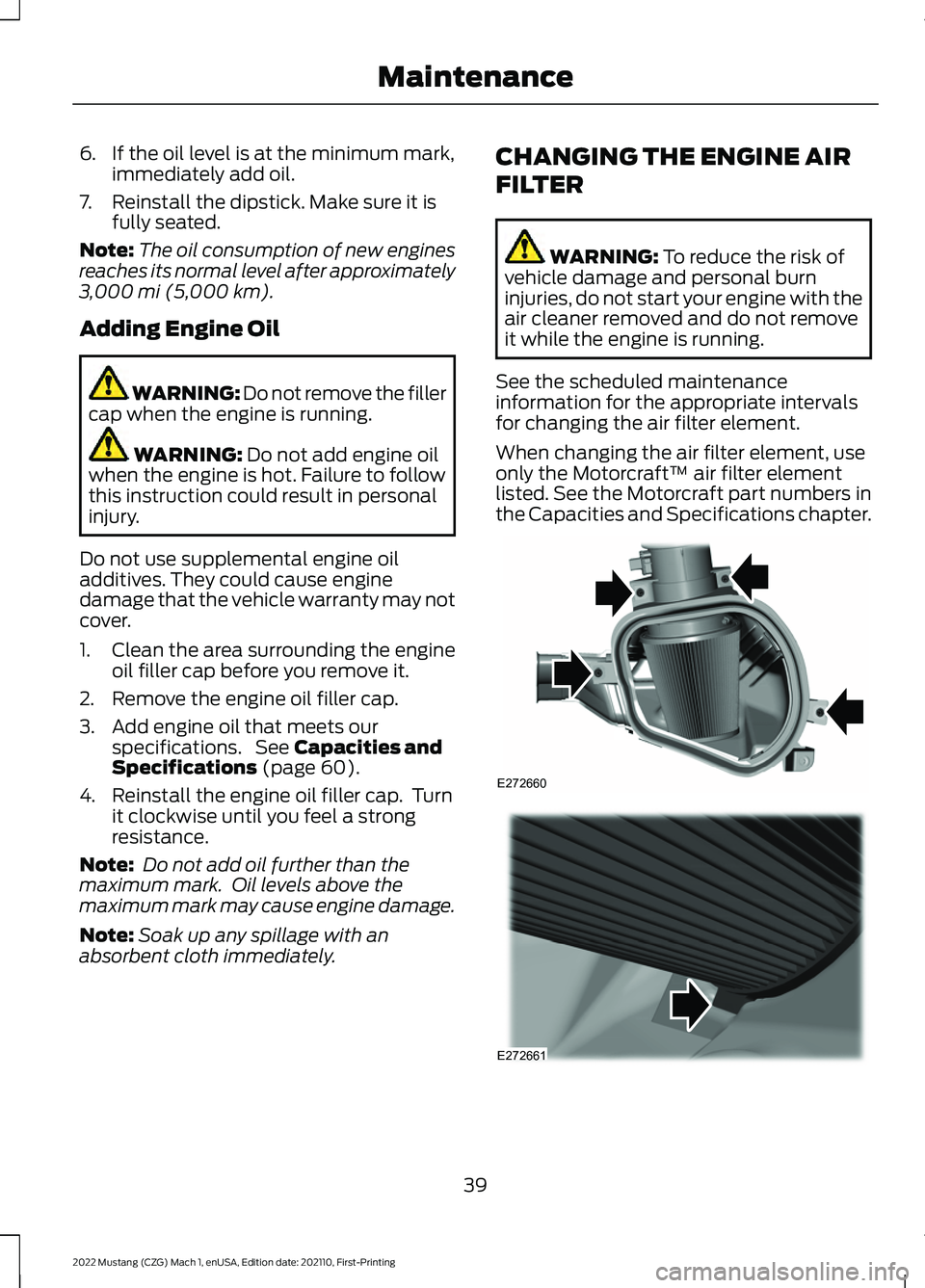
6. If the oil level is at the minimum mark,
immediately add oil.
7. Reinstall the dipstick. Make sure it is fully seated.
Note: The oil consumption of new engines
reaches its normal level after approximately
3,000 mi (5,000 km).
Adding Engine Oil WARNING: Do not remove the filler
cap when the engine is running. WARNING:
Do not add engine oil
when the engine is hot. Failure to follow
this instruction could result in personal
injury.
Do not use supplemental engine oil
additives. They could cause engine
damage that the vehicle warranty may not
cover.
1. Clean the area surrounding the engine oil filler cap before you remove it.
2. Remove the engine oil filler cap.
3. Add engine oil that meets our specifications. See
Capacities and
Specifications (page 60).
4. Reinstall the engine oil filler cap. Turn it clockwise until you feel a strong
resistance.
Note: Do not add oil further than the
maximum mark. Oil levels above the
maximum mark may cause engine damage.
Note: Soak up any spillage with an
absorbent cloth immediately. CHANGING THE ENGINE AIR
FILTER WARNING:
To reduce the risk of
vehicle damage and personal burn
injuries, do not start your engine with the
air cleaner removed and do not remove
it while the engine is running.
See the scheduled maintenance
information for the appropriate intervals
for changing the air filter element.
When changing the air filter element, use
only the Motorcraft™ air filter element
listed. See the Motorcraft part numbers in
the Capacities and Specifications chapter. 39
2022 Mustang (CZG) Mach 1, enUSA, Edition date: 202110, First-Printing MaintenanceE272660 E272661
Page 43 of 81
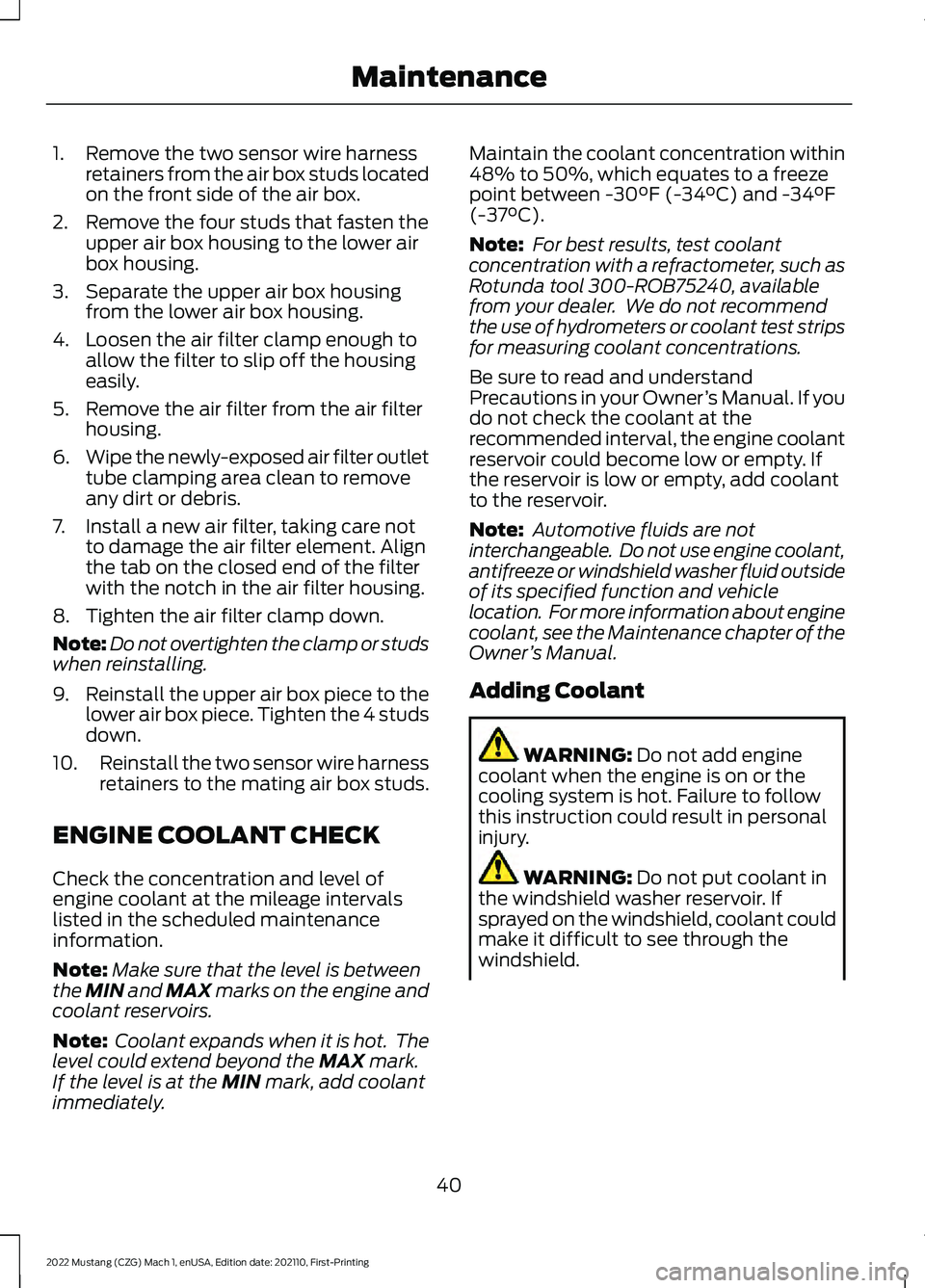
1. Remove the two sensor wire harness
retainers from the air box studs located
on the front side of the air box.
2. Remove the four studs that fasten the upper air box housing to the lower air
box housing.
3. Separate the upper air box housing from the lower air box housing.
4. Loosen the air filter clamp enough to allow the filter to slip off the housing
easily.
5. Remove the air filter from the air filter housing.
6. Wipe the newly-exposed air filter outlet
tube clamping area clean to remove
any dirt or debris.
7. Install a new air filter, taking care not to damage the air filter element. Align
the tab on the closed end of the filter
with the notch in the air filter housing.
8. Tighten the air filter clamp down.
Note: Do not overtighten the clamp or studs
when reinstalling.
9. Reinstall the upper air box piece to the
lower air box piece. Tighten the 4 studs
down.
10. Reinstall the two sensor wire harness
retainers to the mating air box studs.
ENGINE COOLANT CHECK
Check the concentration and level of
engine coolant at the mileage intervals
listed in the scheduled maintenance
information.
Note: Make sure that the level is between
the MIN and MAX marks on the engine and
coolant reservoirs.
Note: Coolant expands when it is hot. The
level could extend beyond the
MAX mark.
If the level is at the MIN mark, add coolant
immediately. Maintain the coolant concentration within
48% to 50%, which equates to a freeze
point between -30°F (-34°C) and -34°F
(-37°C).
Note:
For best results, test coolant
concentration with a refractometer, such as
Rotunda tool 300-ROB75240, available
from your dealer. We do not recommend
the use of hydrometers or coolant test strips
for measuring coolant concentrations.
Be sure to read and understand
Precautions in your Owner ’s Manual. If you
do not check the coolant at the
recommended interval, the engine coolant
reservoir could become low or empty. If
the reservoir is low or empty, add coolant
to the reservoir.
Note: Automotive fluids are not
interchangeable. Do not use engine coolant,
antifreeze or windshield washer fluid outside
of its specified function and vehicle
location. For more information about engine
coolant, see the Maintenance chapter of the
Owner ’s Manual.
Adding Coolant WARNING:
Do not add engine
coolant when the engine is on or the
cooling system is hot. Failure to follow
this instruction could result in personal
injury. WARNING:
Do not put coolant in
the windshield washer reservoir. If
sprayed on the windshield, coolant could
make it difficult to see through the
windshield.
40
2022 Mustang (CZG) Mach 1, enUSA, Edition date: 202110, First-Printing Maintenance
Page 46 of 81
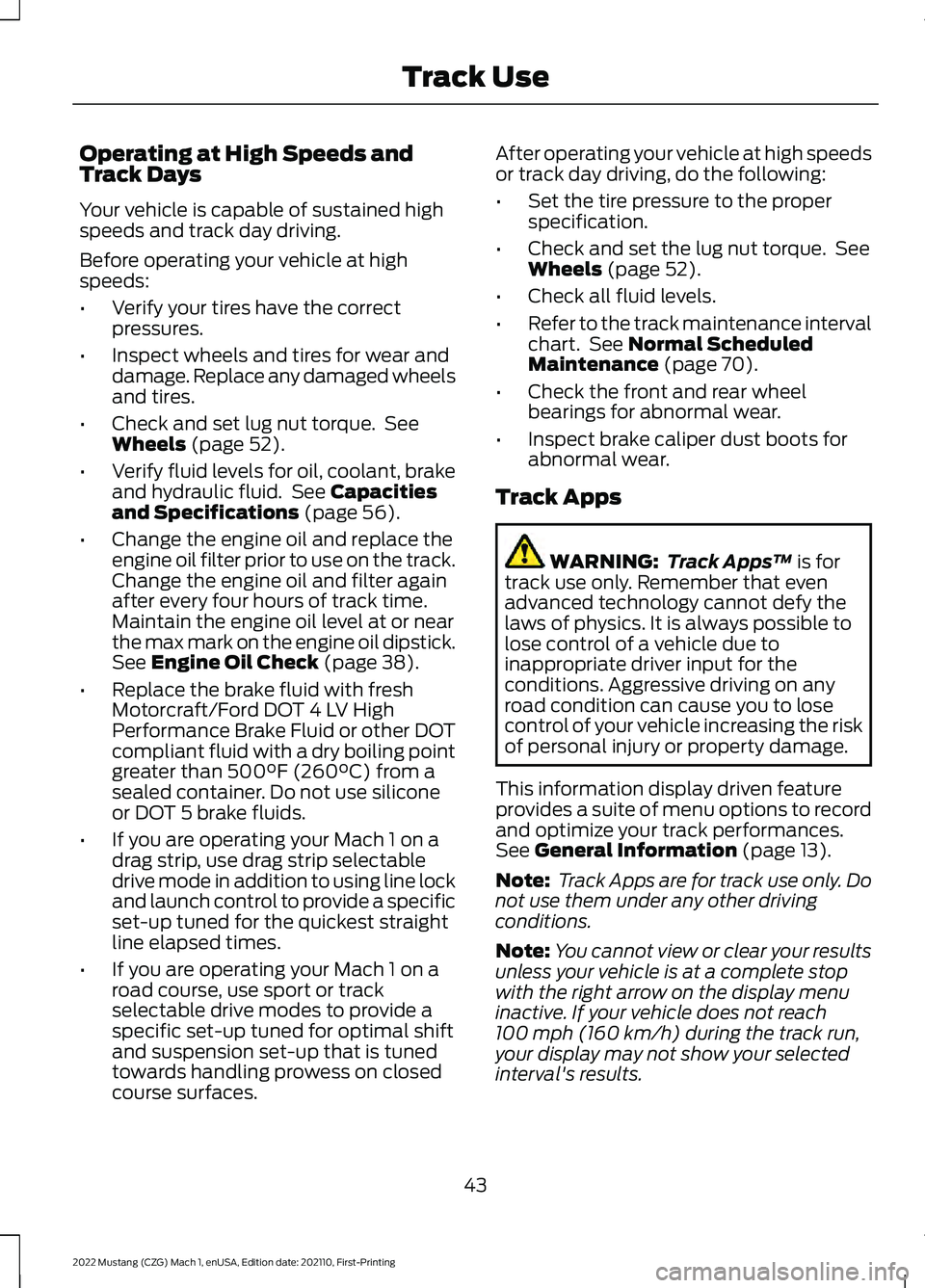
Operating at High Speeds and
Track Days
Your vehicle is capable of sustained high
speeds and track day driving.
Before operating your vehicle at high
speeds:
•
Verify your tires have the correct
pressures.
• Inspect wheels and tires for wear and
damage. Replace any damaged wheels
and tires.
• Check and set lug nut torque. See
Wheels (page 52).
• Verify fluid levels for oil, coolant, brake
and hydraulic fluid. See
Capacities
and Specifications (page 56).
• Change the engine oil and replace the
engine oil filter prior to use on the track.
Change the engine oil and filter again
after every four hours of track time.
Maintain the engine oil level at or near
the max mark on the engine oil dipstick.
See
Engine Oil Check (page 38).
• Replace the brake fluid with fresh
Motorcraft/Ford DOT 4 LV High
Performance Brake Fluid or other DOT
compliant fluid with a dry boiling point
greater than
500°F (260°C) from a
sealed container. Do not use silicone
or DOT 5 brake fluids.
• If you are operating your Mach 1 on a
drag strip, use drag strip selectable
drive mode in addition to using line lock
and launch control to provide a specific
set-up tuned for the quickest straight
line elapsed times.
• If you are operating your Mach 1 on a
road course, use sport or track
selectable drive modes to provide a
specific set-up tuned for optimal shift
and suspension set-up that is tuned
towards handling prowess on closed
course surfaces. After operating your vehicle at high speeds
or track day driving, do the following:
•
Set the tire pressure to the proper
specification.
• Check and set the lug nut torque. See
Wheels
(page 52).
• Check all fluid levels.
• Refer to the track maintenance interval
chart. See
Normal Scheduled
Maintenance (page 70).
• Check the front and rear wheel
bearings for abnormal wear.
• Inspect brake caliper dust boots for
abnormal wear.
Track Apps WARNING:
Track Apps™
is for
track use only. Remember that even
advanced technology cannot defy the
laws of physics. It is always possible to
lose control of a vehicle due to
inappropriate driver input for the
conditions. Aggressive driving on any
road condition can cause you to lose
control of your vehicle increasing the risk
of personal injury or property damage.
This information display driven feature
provides a suite of menu options to record
and optimize your track performances.
See
General Information (page 13).
Note: Track Apps are for track use only. Do
not use them under any other driving
conditions.
Note: You cannot view or clear your results
unless your vehicle is at a complete stop
with the right arrow on the display menu
inactive. If your vehicle does not reach
100 mph (160 km/h)
during the track run,
your display may not show your selected
interval's results.
43
2022 Mustang (CZG) Mach 1, enUSA, Edition date: 202110, First-Printing Track Use
Page 69 of 81
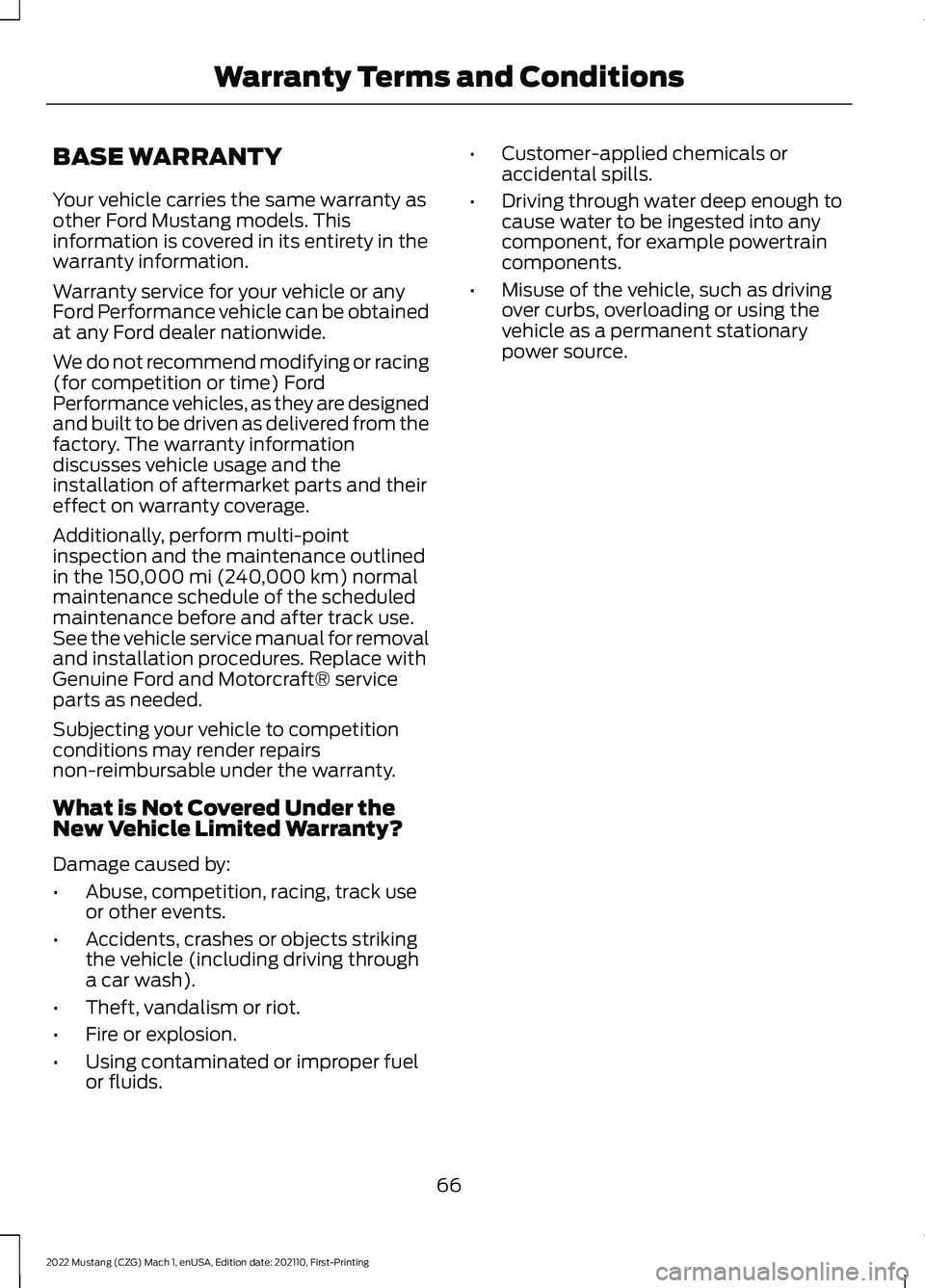
BASE WARRANTY
Your vehicle carries the same warranty as
other Ford Mustang models. This
information is covered in its entirety in the
warranty information.
Warranty service for your vehicle or any
Ford Performance vehicle can be obtained
at any Ford dealer nationwide.
We do not recommend modifying or racing
(for competition or time) Ford
Performance vehicles, as they are designed
and built to be driven as delivered from the
factory. The warranty information
discusses vehicle usage and the
installation of aftermarket parts and their
effect on warranty coverage.
Additionally, perform multi-point
inspection and the maintenance outlined
in the 150,000 mi (240,000 km) normal
maintenance schedule of the scheduled
maintenance before and after track use.
See the vehicle service manual for removal
and installation procedures. Replace with
Genuine Ford and Motorcraft® service
parts as needed.
Subjecting your vehicle to competition
conditions may render repairs
non-reimbursable under the warranty.
What is Not Covered Under the
New Vehicle Limited Warranty?
Damage caused by:
• Abuse, competition, racing, track use
or other events.
• Accidents, crashes or objects striking
the vehicle (including driving through
a car wash).
• Theft, vandalism or riot.
• Fire or explosion.
• Using contaminated or improper fuel
or fluids. •
Customer-applied chemicals or
accidental spills.
• Driving through water deep enough to
cause water to be ingested into any
component, for example powertrain
components.
• Misuse of the vehicle, such as driving
over curbs, overloading or using the
vehicle as a permanent stationary
power source.
66
2022 Mustang (CZG) Mach 1, enUSA, Edition date: 202110, First-Printing Warranty Terms and Conditions
Page 70 of 81

GENERAL MAINTENANCE
INFORMATION
Why Maintain Your Vehicle?
Carefully following the maintenance
schedule helps protect against major repair
expenses resulting from neglect or
inadequate maintenance and may help to
increase the value of your vehicle when
you sell or trade it. Keep all receipts for
completed maintenance with your vehicle.
We have established regular maintenance
intervals for your vehicle based upon
rigorous testing. It is important that you
have your vehicle serviced at the proper
times. These intervals serve two purposes;
one is to maintain the reliability of your
vehicle and the second is to keep your cost
of owning your vehicle down.
It is your responsibility to have all
scheduled maintenance performed and to
make sure that the materials used meet
the specifications identified in this owner's
manual. See Capacities and
Specifications (page 56).
Failure to perform scheduled maintenance
invalidates warranty coverage on parts
affected by the lack of maintenance.
Why Maintain Your Vehicle at Your
Dealership?
Factory-Trained Technicians
Service technicians participate in extensive
factory-sponsored certification training to
help them become experts on the
operation of your vehicle. Ask your
dealership about the training and
certification their technicians have
received. Genuine Ford and Motorcraft®
Replacement Parts
Dealerships stock Ford, Motorcraft and
Ford-authorized branded re-manufactured
replacement parts. These parts meet or
exceed our specifications. Parts installed
at your dealership carry a nationwide
24-month or unlimited mile (kilometer)
parts and labor limited warranty.
If you do not use Ford authorized parts they
may not meet our specifications and
depending on the part, it could affect
emissions compliance.
Convenience
Many dealerships have extended evening
and Saturday hours to make your service
visit more convenient and they offer one
stop shopping. They can perform any
services that are required on your vehicle,
from general maintenance to collision
repairs.
Note:
Not all dealers have extended hours
or body shops. Please contact your dealer
for details.
Protecting Your Investment
Maintenance is an investment that pays
dividends in the form of improved
reliability, durability and resale value. To
maintain the proper performance of your
vehicle and its emission control systems,
make sure you have scheduled
maintenance performed at the designated
intervals.
Your vehicle is equipped with an intelligent
oil-life monitor that determines oil life
based on engine operating conditions.
67
2022 Mustang (CZG) Mach 1, enUSA, Edition date: 202110, First-Printing Scheduled Maintenance
Page 71 of 81
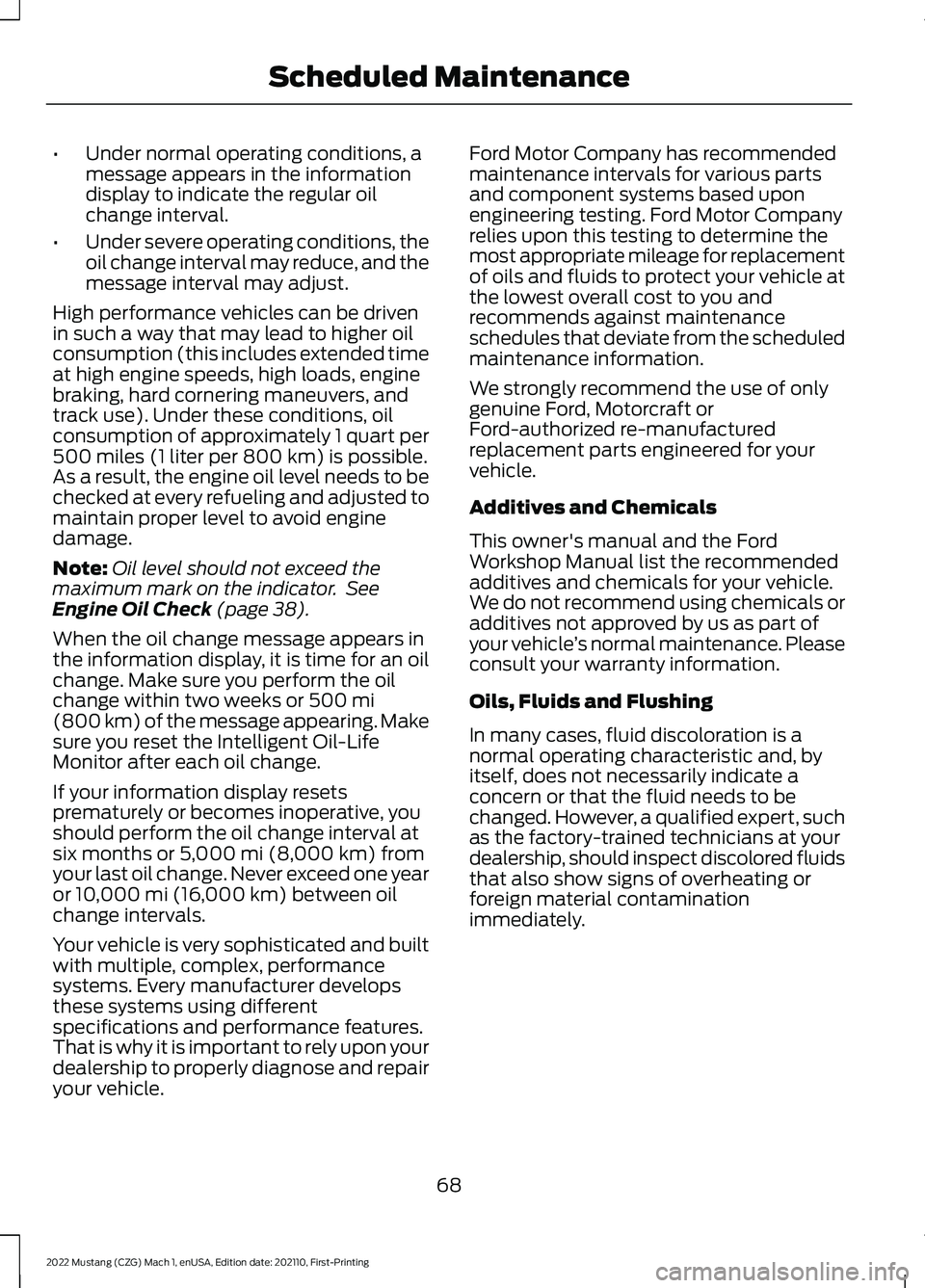
•
Under normal operating conditions, a
message appears in the information
display to indicate the regular oil
change interval.
• Under severe operating conditions, the
oil change interval may reduce, and the
message interval may adjust.
High performance vehicles can be driven
in such a way that may lead to higher oil
consumption (this includes extended time
at high engine speeds, high loads, engine
braking, hard cornering maneuvers, and
track use). Under these conditions, oil
consumption of approximately 1 quart per
500 miles (1 liter per 800 km) is possible.
As a result, the engine oil level needs to be
checked at every refueling and adjusted to
maintain proper level to avoid engine
damage.
Note: Oil level should not exceed the
maximum mark on the indicator. See
Engine Oil Check (page 38).
When the oil change message appears in
the information display, it is time for an oil
change. Make sure you perform the oil
change within two weeks or
500 mi
(800 km) of the message appearing. Make
sure you reset the Intelligent Oil-Life
Monitor after each oil change.
If your information display resets
prematurely or becomes inoperative, you
should perform the oil change interval at
six months or
5,000 mi (8,000 km) from
your last oil change. Never exceed one year
or
10,000 mi (16,000 km) between oil
change intervals.
Your vehicle is very sophisticated and built
with multiple, complex, performance
systems. Every manufacturer develops
these systems using different
specifications and performance features.
That is why it is important to rely upon your
dealership to properly diagnose and repair
your vehicle. Ford Motor Company has recommended
maintenance intervals for various parts
and component systems based upon
engineering testing. Ford Motor Company
relies upon this testing to determine the
most appropriate mileage for replacement
of oils and fluids to protect your vehicle at
the lowest overall cost to you and
recommends against maintenance
schedules that deviate from the scheduled
maintenance information.
We strongly recommend the use of only
genuine Ford, Motorcraft or
Ford-authorized re-manufactured
replacement parts engineered for your
vehicle.
Additives and Chemicals
This owner's manual and the Ford
Workshop Manual list the recommended
additives and chemicals for your vehicle.
We do not recommend using chemicals or
additives not approved by us as part of
your vehicle
’s normal maintenance. Please
consult your warranty information.
Oils, Fluids and Flushing
In many cases, fluid discoloration is a
normal operating characteristic and, by
itself, does not necessarily indicate a
concern or that the fluid needs to be
changed. However, a qualified expert, such
as the factory-trained technicians at your
dealership, should inspect discolored fluids
that also show signs of overheating or
foreign material contamination
immediately.
68
2022 Mustang (CZG) Mach 1, enUSA, Edition date: 202110, First-Printing Scheduled Maintenance
Page 72 of 81
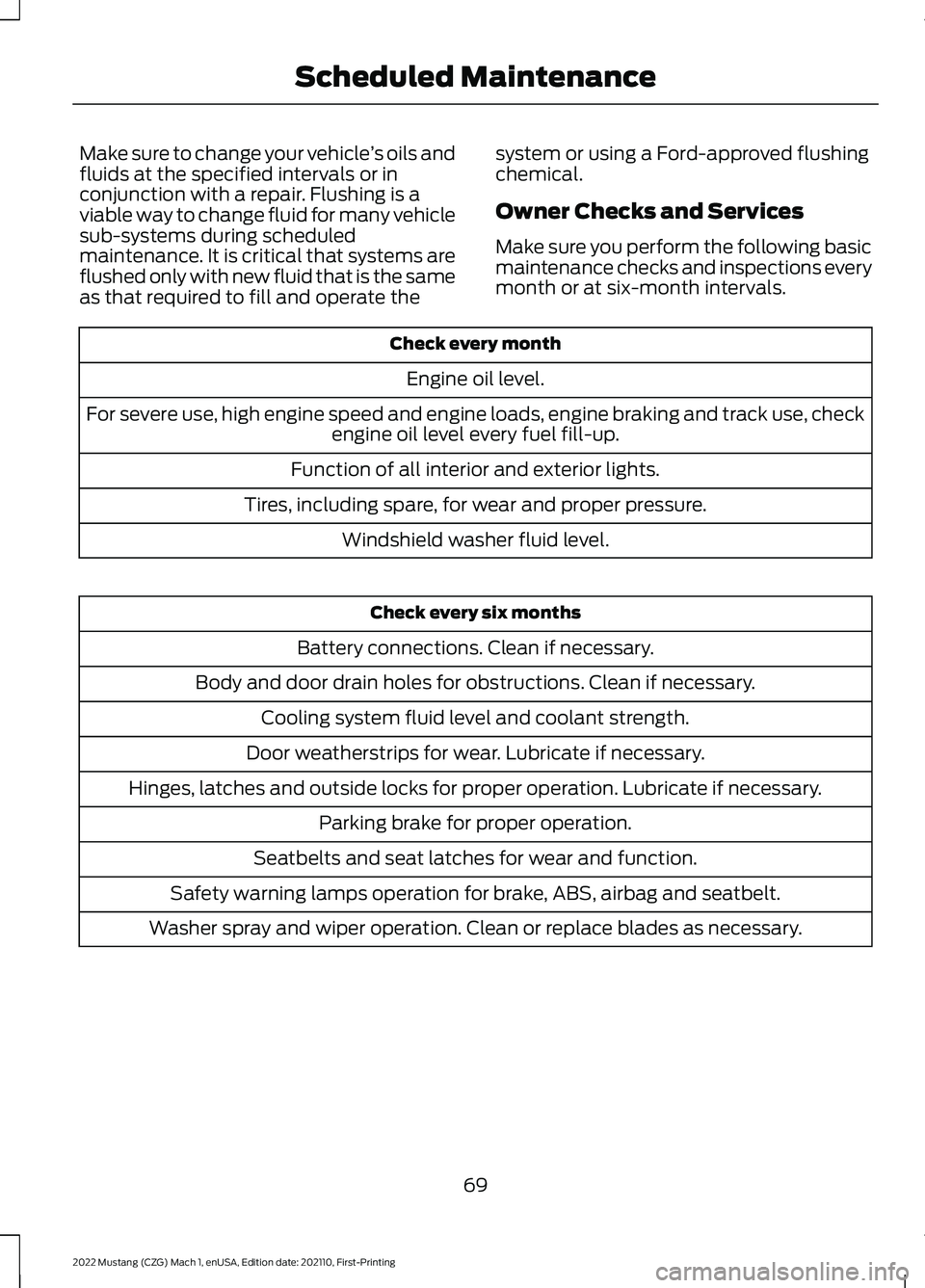
Make sure to change your vehicle
’s oils and
fluids at the specified intervals or in
conjunction with a repair. Flushing is a
viable way to change fluid for many vehicle
sub-systems during scheduled
maintenance. It is critical that systems are
flushed only with new fluid that is the same
as that required to fill and operate the system or using a Ford-approved flushing
chemical.
Owner Checks and Services
Make sure you perform the following basic
maintenance checks and inspections every
month or at six-month intervals.Check every month
Engine oil level.
For severe use, high engine speed and engine loads, engine braking and track use, check engine oil level every fuel fill-up.
Function of all interior and exterior lights.
Tires, including spare, for wear and proper pressure. Windshield washer fluid level. Check every six months
Battery connections. Clean if necessary.
Body and door drain holes for obstructions. Clean if necessary. Cooling system fluid level and coolant strength.
Door weatherstrips for wear. Lubricate if necessary.
Hinges, latches and outside locks for proper operation. Lubricate if necessary. Parking brake for proper operation.
Seatbelts and seat latches for wear and function.
Safety warning lamps operation for brake, ABS, airbag and seatbelt.
Washer spray and wiper operation. Clean or replace blades as necessary.
69
2022 Mustang (CZG) Mach 1, enUSA, Edition date: 202110, First-Printing Scheduled Maintenance
Page 73 of 81
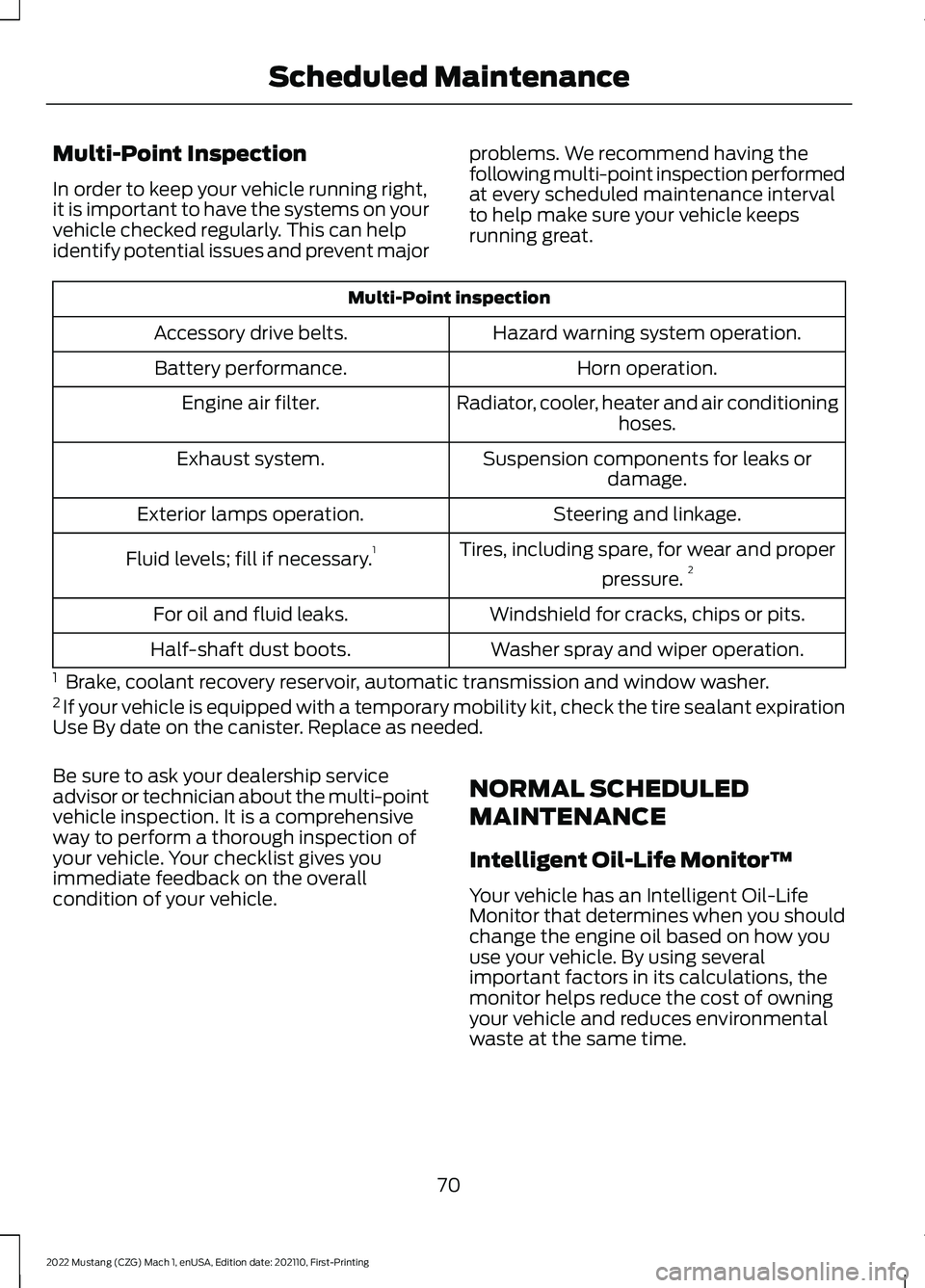
Multi-Point Inspection
In order to keep your vehicle running right,
it is important to have the systems on your
vehicle checked regularly. This can help
identify potential issues and prevent major
problems. We recommend having the
following multi-point inspection performed
at every scheduled maintenance interval
to help make sure your vehicle keeps
running great.Multi-Point inspection
Hazard warning system operation.
Accessory drive belts.
Horn operation.
Battery performance.
Radiator, cooler, heater and air conditioninghoses.
Engine air filter.
Suspension components for leaks ordamage.
Exhaust system.
Steering and linkage.
Exterior lamps operation.
Tires, including spare, for wear and properpressure.2
Fluid levels; fill if necessary. 1
Windshield for cracks, chips or pits.
For oil and fluid leaks.
Washer spray and wiper operation.
Half-shaft dust boots.
1 Brake, coolant recovery reservoir, automatic transmission and window washer.
2 If your vehicle is equipped with a temporary mobility kit, check the tire sealant expiration
Use By date on the canister. Replace as needed.
Be sure to ask your dealership service
advisor or technician about the multi-point
vehicle inspection. It is a comprehensive
way to perform a thorough inspection of
your vehicle. Your checklist gives you
immediate feedback on the overall
condition of your vehicle. NORMAL SCHEDULED
MAINTENANCE
Intelligent Oil-Life Monitor™
Your vehicle has an Intelligent Oil-Life
Monitor that determines when you should
change the engine oil based on how you
use your vehicle. By using several
important factors in its calculations, the
monitor helps reduce the cost of owning
your vehicle and reduces environmental
waste at the same time.
70
2022 Mustang (CZG) Mach 1, enUSA, Edition date: 202110, First-Printing Scheduled Maintenance
Page 74 of 81
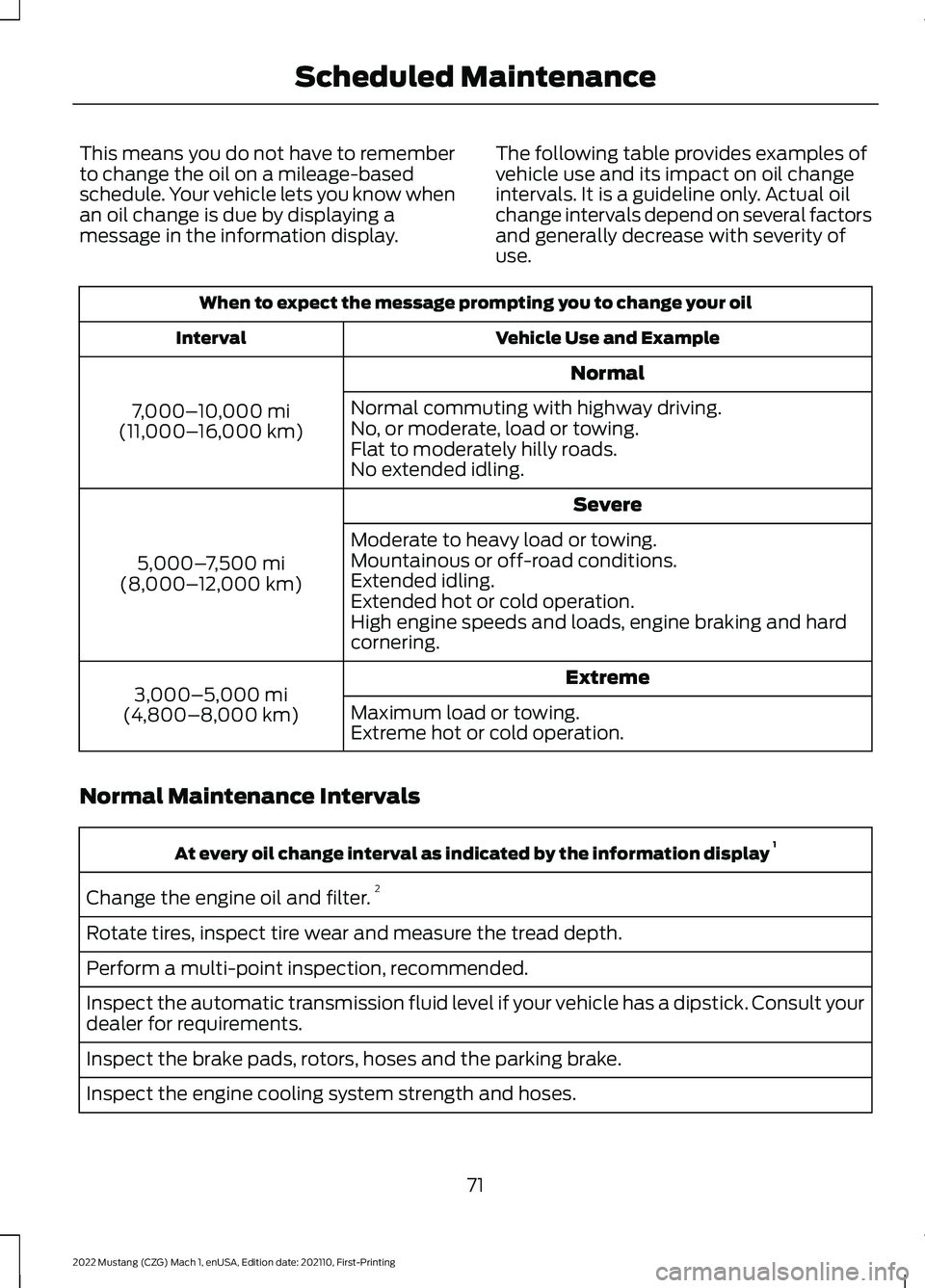
This means you do not have to remember
to change the oil on a mileage-based
schedule. Your vehicle lets you know when
an oil change is due by displaying a
message in the information display.
The following table provides examples of
vehicle use and its impact on oil change
intervals. It is a guideline only. Actual oil
change intervals depend on several factors
and generally decrease with severity of
use.When to expect the message prompting you to change your oil
Vehicle Use and Example
Interval
Normal
7,000– 10,000 mi
(11,000– 16,000 km) Normal commuting with highway driving.
No, or moderate, load or towing.
Flat to moderately hilly roads.
No extended idling.
Severe
5,000– 7,500 mi
(8,000– 12,000 km) Moderate to heavy load or towing.
Mountainous or off-road conditions.
Extended idling.
Extended hot or cold operation.
High engine speeds and loads, engine braking and hard
cornering.
Extreme
3,000–5,000 mi
(4,800–8,000 km) Maximum load or towing.
Extreme hot or cold operation.
Normal Maintenance Intervals At every oil change interval as indicated by the information display
1
Change the engine oil and filter. 2
Rotate tires, inspect tire wear and measure the tread depth.
Perform a multi-point inspection, recommended.
Inspect the automatic transmission fluid level if your vehicle has a dipstick. Consult your
dealer for requirements.
Inspect the brake pads, rotors, hoses and the parking brake.
Inspect the engine cooling system strength and hoses.
71
2022 Mustang (CZG) Mach 1, enUSA, Edition date: 202110, First-Printing Scheduled Maintenance